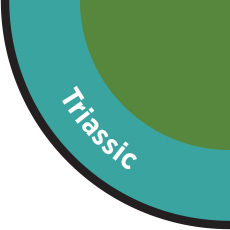

Early in the Triassic, many reptiles returned to the sea to join—and eat—the bony fishes and abundant mollusks there. Placodonts, like this one approaching the seafloor with mouth agape, paddled slowly in pursuit of clams, snails, and brachiopods that they crushed with broad, flat teeth. More streamlined, web-footed nothosaurs (swimming to the placodont’s right) and thalattosaurs snagged fishes with the aid of long snouts and sharp teeth. The first teleosts (bony fishes with a symmetrical tail fin and extendible jaws) evolved in the Triassic around 215 million years ago; today, almost all fish species belong to this group.

The skull of the placodont (“plate tooth”) Macroplacus raeticus featured flat, crushing teeth and strong jaws, for this reptile ate shellfish.

Slender-bodied Askeptosaurus italicus was a primitive member of the thalattosaurs, a group of marine reptiles that lived only during the Triassic.

Saurichthys, a barracuda-like predator, belonged to the primitive group of ray-finned fishes that includes today’s gars and sturgeon.

The nothosaur Neusticosaurus edwardsii swam by undulating its long, thin body.